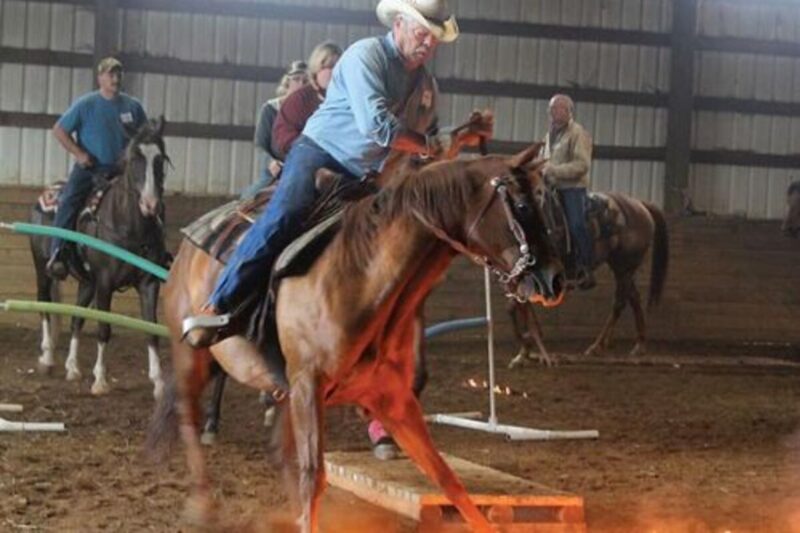Sean C. Morgan
Horses, as a rule, don’t much care for fire, loud noises, flares and smoke, and they don’t enjoy walking through thick brush.
But when you’re a trusty steed serving in the Linn County Sheriff’s Posse, your rider is going to want you to negotiate a wide variety of situations, each presenting different obstacles, crowds and random noise.
That’s why Bill Richey, founder and director of National Mounted Police Services, visited Chafin Farms on June 26 to help local Posse members train their horses and “de-spook” them.
During the training, hosted by LaDonna and Larry Chafin, members of the Mounted Posse rode their horses through increasingly more difficult obstacles, culminating in multiple fires for the horses to cross, while sirens and lights flashed in the arena.
The Mounted Posse has existed for more than 50 years, said Posse Captain Mary Shellenbarger of Buena Vista. It has about 30 members and a half-dozen new probationary members.
Among its duties is security at the county fair, search and rescue and crowd control.
The goal is for the horses to look for their riders’ direction and overcome their flight instinct and maintain their composure, said LaDonna Chafin. “(Richey) explained a lot about a horse’s eye. They’re like trifocals.”
When the head is up, the horse is looking into the distance, and obstacles at each level and on different sides affect the horse differently. He also talked about the psychology of horses, how their brains work.
The horse’s small brain is divided like a human brain, Richey said, but it has far fewer connections between the hemispheres, allowing for instinct-level communication between them.
“He was awesome to hear this morning,” Chafin said.
Shellenbarger said the training is vital for crowd control and more.
“It’s for any situation where we happen to find ourselves.”
The posse often works search and rescue, putting its members and horses in the woods, with bridges that are a lot like the plywood scattered along the obstacle course in the arena, Shellenbarger said. Foam swimming noodles simulated tree limbs.
Riders need to know their horses will go through closely growing trees and limbs, she said, to help ensure that posse members and horses do not become a liability to the Sheriff’s Office.
The posse is often in parades and works crowd control, she said. Loud noises are everywhere, and children or dogs may rush out. In one parade, Shellenbarger recalled, a child rushed out to hug the hind leg of a horse.
But usually in a crowd, it’s a dog that’ll come out, barking and even nipping at the horses.
Richey’s German shepherd, PD, helped out by harassing the horses while they negotiated the obstacle course.
“They’re doing pretty well, overall,” Shellenbarger said of the trainees. “A lot of this is new to about half of them. Even with the best-trained horse, you need to learn to expect anything.
“It gives the riders something to think about what their horse might be thinking.”
The idea is to wear the horses out going through the obstacles, starting with just a few simple obstacles, Richey said. As the exercise continues, he adds more distractions, noises and obstacles. But the buildup must be slow. Too fast, the horses will refuse to go through the obstacles.
Ultimately, it teaches the horse to rely on the rider for direction, he said. “It teaches (the horse) no matter what, he doesn’t get hurt. All he has to do is go forward, and life is good. You’ve got to make them trust you to get them to go through anything.
“We’re just preparing these guys for anything that can go wrong.”





